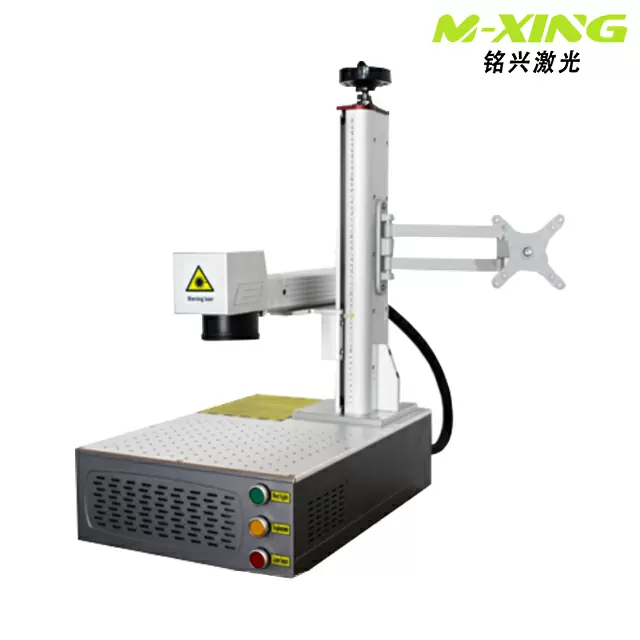A small fiber laser engraver works based on the principles of laser technology.
Here’s a breakdown of its basic operating principle:
Laser Generation: The small fiber laser engraver generates a laser beam using a fiber laser source. A fiber laser consists of a gain medium, typically a doped fiber, that is excited by pumping it with high-intensity light, usually from diode lasers. This excitation stimulates the gain medium to emit coherent light at a specific wavelength, typically in the infrared range.
Beam Delivery: The laser beam is guided through a flexible fiber optic cable to the laser head or focusing lens assembly. The fiber optic cable ensures efficient and precise delivery of the laser beam to the desired location.
Focusing: The laser beam passes through a focusing lens within the laser head. The lens focuses the laser beam to a small spot size, which determines the level of detail and precision achievable during the engraving process.
Material Interaction: The focused laser beam interacts with the material being engraved. The high energy density of the laser beam causes localized heating of the material, leading to vaporization, melting, or ablation depending on the engraving parameters and material properties.
Control and Motion System: The small fiber laser engraver is equipped with a control system that precisely controls the movement of the laser head or the workpiece. This control system allows for accurate positioning and movement of the laser beam during the engraving process.
Engraving Patterns: The desired design or pattern to be engraved is typically input into the engraver through computer software. The software controls the laser parameters such as power, speed, and frequency, allowing for customization and flexibility in the engraving process.
Engraving Process: As the laser head moves across the material surface, the laser beam selectively removes or alters the material, creating the desired engraving pattern. The engraving depth and width can be controlled by adjusting the laser power and speed.
Cooling and Exhaust: During the engraving process, the small fiber laser engraver generates heat. Proper cooling systems, such as air or water cooling, are employed to maintain optimal operating temperatures. An exhaust system removes any fumes or debris generated during engraving to maintain a clean working environment.
Overall, the small fiber laser engraver utilizes a high-powered laser beam to selectively remove or alter material to create precise and detailed engravings. The flexibility, speed, and accuracy of the engraving process make fiber laser engravers popular for a wide range of applications in various industries.
What is the minimum line width or level of detail that can be achieved with a small fiber laser engraver?
The minimum line width or level of detail that can be achieved with a small fiber laser engraver depends on several factors, including the laser’s power, focusing capability, and the material being engraved. Here are some general considerations:
Laser Power: Higher laser power generally allows for finer and more precise engraving details. A small fiber laser engraver typically has a power range of a few watts to tens of watts. Higher-power lasers can achieve finer line widths and intricate details compared to lower-power lasers.
Focusing Capability: The focusing capability of the laser engraver’s lens plays a significant role in determining the minimum line width. small fiber laser engraver A smaller focal spot size achieved through high-quality lenses enables finer details in the engraving. The focusing capability is influenced by the lens quality, lens diameter, and the engraving setup.
Material Properties: Different materials have varying responses to laser engraving due to their composition and physical properties. Some materials may have a higher tendency to melt, vaporize, or char, affecting the achievable level of detail. Softer materials like plastics may allow for finer details compared to harder materials like metals.
Engraving Speed: The speed at which the laser head moves during the engraving process can impact the level of detail. Slower speeds generally allow for finer details, but this may increase the overall engraving time.
Resolution and DPI: The resolution of the engraving image or design file, measured in dots per inch (DPI), also influences the level of detail. Higher resolution images can capture finer details, but it’s important to ensure that the engraver’s capabilities align with the desired resolution.
While it’s challenging to provide an exact minimum line width or level of detail that can be achieved with a small fiber laser engraver without specific details about the machine and materials, it is not uncommon for small fiber laser engravers to achieve line widths of around 0.02mm or even smaller, enabling intricate and precise engravings.
It’s advisable to consult the manufacturer or supplier of the specific small fiber laser engraver you are considering to get more precise information about its capabilities and the level of detail it can achieve for your desired applications. Additionally, conducting tests or requesting sample engravings using your specific materials can provide a better understanding of the machine’s performance for your specific needs.

